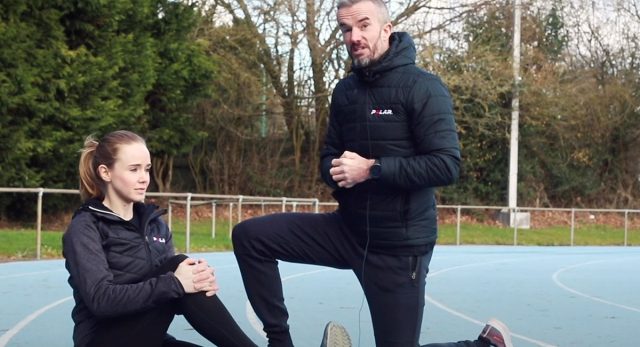Hybrid workouts are a great way to combine two different areas of working out into one session. This is especially useful if you’re a runner because chances are that as a runner most of your workouts consist of putting in miles on the road. While this isn’t necessarily a bad thing, it can be easy to get burned out by the monotony of the same old workout.
On the other hand, adding variety to your running routine can not only keep you mentally fresh but also keep you from hitting a plateau in your fitness. As hybrid or combo workouts have become popular recently, we thought it might be useful to dig deeper into the principles of combining strength and endurance training into a single high-intensity session.
Here Leanne Pedante, co-founder of a new fitness concept studio called STRIDE, sheds light on how hybrid workouts can be used to benefit running performance and prevent injury.
What are Hybrid Workouts?
While there are many different types, hybrid style running workouts typically combine strength and endurance training into one workout.
Since most runners have a love/hate relationship when it comes to the gym, this new way of thinking about strength training – that doesn’t rely on a one or the other approach – can help keep you from getting burnt out if you’re the type of person who gets bored easily.
“At STRIDE, we call them our COMBO workouts,” Pedante says. “Combo, or ‘hybrid’ running workouts are comprised of a mixture of intervals of treadmill running and intervals of strength training. For folks who want a high-intensity workout with a challenging balance of cardio and strength training, these are perfect.”
The good news is, you don’t need to be an advanced runner to give this style of workout a try. Whether you’re a beginner looking to lose weight or a marathoner looking to work on your weaknesses to boost performance, there is something any runner can gain from including this high-intensity session into your current routine once or twice per week.
Benefits of Hybrid Running Workouts
One of the biggest challenges new runners face is getting into a consistent routine as they build fitness. While hybrid style workouts can seem more challenging than simply heading out for a two- or three-mile run, Pedante recommends giving it a try.
“Combo (or hybrid) workouts are perfect for beginner runners, or folks who might not even think of themselves as runners at all,” Pedante says. “Since the treadmill intervals are short and mixed in with strength-training moves, this can be a great way to ease in newer runners. At STRIDE, we consistently hear new clients protest, ‘I can’t run!’ before they take their first class. Then, 55 minutes later, they’ve finished a total-body strength workout and logged two to three miles on the treadmill without even thinking about it.”
Mixing up the pace and keeping repetitions short aren’t the only benefits. For the other type of runner who spends a majority of their time logging long miles, it can be a great way to get in speed work while also focusing on those parts of your body running tends to neglect.
“Lots of runners focus entirely on mileage but are missing the strength-training they need to stay strong and injury-free,” Pedante says. “Combo (or hybrid) workouts are great for this group too because you can sneak in essential strength-training while disguising it as an interval running workout.”
Whether it’s working on your core, building upper body strength, or focusing on a part of the body you’ve had a history of injuries with, hybrid running workouts can help you work on these weaknesses to become a better, more efficient runner.
What to Consider in hybrid workouts?
Like anything else, when you’re trying a new type of workout, it’s best to start slow and allow your body to adapt over a period of time to avoid injury. This can take several weeks or months, and even then you’ll want to limit the number of sessions per week to no more than two or three because of the high-intensity nature of the workouts.
Pedante also recommends backing off just a little for the first few sessions to until you get used to the effort.
“Even the most experienced runners may find that their normal fast speed isn’t so easy once they’ve just finished a round of squat jumps,” Pedante says. “If this is your first time mixing strength into your running workouts, or vice versa, plan to go a little slower on your speeds and choose slightly lighter weights until you’ve done a few and know what to expect.”
Another way to keep an eye on your intensity and make sure you’re recovered before you try your next session is to monitor your heart rate. Pedante says coordinating your repetitions with your heart rate is a good idea, and can help you get the most out of your workout.
“For high-intensity workouts, you want your recovery times to be intelligently designed,” Pedante says. “It should be short enough that you stay in an active recovery zone while your muscles are warm but long enough that your heart rate can recover slightly and feel restored enough to attack your upcoming interval with focus. A heart rate monitor is the easiest way to find the right balance.”
While there are many good options, GPS watches like the Polar Vantage M can help you monitor your heart rate in the desired heart rate zone and also provide metrics that let you know if you’ve recovered properly prior to your next training session. This will help keep you from pushing too hard during your workout, provide insight into how many recovery days you need in between sessions, and help to prevent an unnecessary injury or overtraining from occurring.
Hybrid Workout to Get You Started: 60-Minute Upper Body COMBO
To help get you started, here’s a hybrid workout Pedante uses at her STRIDE studio for runners looking to work on speed and upper body strength.
Equipment Needed: Treadmill and a pair of dumbbells
Warm-up: Three-minute dynamic exercises including high knees, leg sweeps, butt kickers. Follow this with:
- Warm-up jogging for five minutes (1% incline)
- Run for 90 seconds at your fast pace (2% incline), then follow with a 45-second recovery.
- Run for 90 seconds at your fast pace (3% incline), then follow with a 45-second recovery.
- Run for 90 seconds at your fast pace (4% incline), then follow with a 45-second recovery.
The following sets contain two treadmill intervals followed by a three-minute strength block. Use a heart rate monitor to determine rest times.
Set 1
- Three minutes of running. Begin at your endurance pace (10K pace) and increase speed every 60 seconds (incline 1%).
- Recover for 45 seconds walking or jogging.
- Run for 90 seconds (5% incline) at your endurance pace.
- Recover for 45 seconds walking or jogging.
- Follow with this three-minute strength circuit:
- Move quickly, completing as many rounds as possible of these exercises within four minutes. Use dumbbells heavy enough to cause fatigue by your eighth repetition.
- Complete 12 repetitions of dumbbell chest press with glute bridge.
- Complete 12 repetitions of incline pushups with alternating high reach to ceiling (feet on the treadmill, hands on the ground).
- Recover for 45 seconds walking or jogging.
Set 2
- Run for three minutes at your endurance or 10K pace. Start at 1% incline and increase by 1% every 60 seconds.
- Recover for 45 seconds walking or jogging.
- Run for 90 seconds at your fast pace (1% incline).
- Recover for 45 seconds walking or jogging.
- Follow with this three-minute strength circuit:
- 10 repetitions of hammer curls
- 10 repetitions of wide-angle bicep curls
- 10 repetitions of tricep dips (hands on the edge of the treadmill)
- Recover for 45 seconds walking or jogging.
Set 3
- Run for two minutes at your fast pace (2% incline).
- Recover for 45 seconds walking or jogging.
- Run for 90 seconds at your endurance pace (5% incline).
- Follow with this three-minute strength circuit:
- 10 repetitions of hammer curls
- 8 repetitions of standing lateral raises
- 8 repetitions of reverse flys
- Recover for 45 seconds walking or jogging.
Set 4
- Run for two minutes at your fast pace (1% incline).
- Recover for 45 seconds walking or jogging.
- Run for 90 seconds at a slightly faster pace (1% incline)
- Follow with this three-minute strength circuit:
- 20 repetitions of dead bugs while holding dumbbells
- 20 repetitions of supermans while holding dumbbells
- Recover for 45 seconds walking or jogging.
Finisher sprints
- Sprint for 30 seconds (1% incline), followed by 60 seconds of recovery. Repeat twice.
- Finish with three minutes of recovery jogging to cool down.
If you liked this post, don’t forget to share so that others can find it, too.
Or give it a thumbs up!
I like this article
Please note that the information provided in the Polar Blog articles cannot replace individual advice from health professionals. Please consult your physician before starting a new fitness program.





